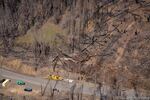
Stacks of logs from hazard trees removed along Highway 224 next to the Wild and Scenic corridor of the Clackamas River.
Trip Jennings
More and more workers are lining up to blow the whistle on a state project that they say is irresponsibly removing trees along roads and properties that burned in last year’s wildfires.
Multiple people who have worked for Oregon Department of Transportation contractors have now come forward to flag problems with the state’s hazard tree removal project.
Lawmakers heard many of their concerns at a hearing before the Senate Natural Resources and Wildfire Committee on Wednesday, and are now considering their options for trying to stop the work until it can be reviewed.
On Thursday, committee chair Jeff Golden, D-Ashland, sent a letter to Gov. Kate Brown asking her to suspend the state’s tree removal operation and order an investigation of the allegations shared in Wednesday’s testimony. He flagged concerns that mismanagement of the state contracts could jeopardize Federal Emergency Management disaster funding that the state is counting on to help pay for wildfire cleanup work.
“The testimony was alarming,” Golden wrote. “There are multiple allegations that core elements of the project’s stated purpose and specifications are being violated. … If any of these allegations are substantially true, the negative consequences for our state would be grave in a number of ways.”
Golden told the governor his committee is not qualified to assess the allegations, but that no more trees should be felled under the existing contracts until an “on-the-ground inquiry” can “ascertain the facts.”
Charles Boyle, deputy communications director for Brown, said the governor’s office is reviewing the senator’s letter and state agencies are responding to questions and concerns.
“Communities across Oregon were devastated by wildfires last year, and it is critical that we support Oregonians in rebuilding those communities as soon as possible. Removal of hazardous trees is a key step towards doing so,” Boyle said.
The state is in the midst of a massive effort to cut down an estimated 140,000 burned trees that could be dangerous to people on state roads or burned properties.
The project is using contractors and subcontractors who have now been accused by former employees of potentially fraudulent mismanagement.
At the hearing, workers who held a variety of positions with two key companies, CDR Maguire and Mason, Bruce & Girard, shared firsthand accounts of how the companies failed to develop proper guidelines for which trees to cut, allowed inexperienced workers to mark trees for removal using a phone application, marked trees for removal that aren’t actually hazardous and allowed contractors to cut trees into wetlands without proper precautions.
Ron Carmickle, mayor of the city of Gates, told lawmakers he was stunned to see “literally thousands of trees” marked with blue paint for removal along the roads and property in his town, and he’s worried that the guidelines being used to determine which trees are hazardous are flawed.
“This is not OK with me,” he said. “We have a major problem going on here in Oregon. I believe our beautiful state is being rampaged. I believe money that should be used to rebuild our state is being pilfered by contractors and corporations set to profit from our devastation.”
He asked lawmakers to do what they can to stop the project.
“Please help stop the ugliness and stop this excessive and needless cutting of healthy trees,” he said. “Please, please, please save our beautiful state.”
Sen. Prozanski, D-Eugene, said the accusations against ODOT’s contractors are serious enough that lawmakers may consider asking the Oregon State Police to conduct an independent investigation into the project, “including potential criminal conduct.”
“We need to think about calling for an immediate stop to the tree removal that’s occurring right now until we can have oversight,” he said.
Committee chair Sen. Jeff Golden, D-Ashland, said lawmakers don’t have authority to stop the project but can send a request to state leaders who do have that authority.
“What risk would be run if in fact there were a pause, a fairly short pause, for a vetting of some of these assertions that go way beyond what we’re able to do sitting here in committee?” he asked. “Because I think that’s something we at least want to discuss.”
Sen. Deb Patterson, D-Salem, was one of several lawmakers on the committee who said they want to continue the hearing. She raised concerns about why Oregon hired Miami-based CDR Maguire to oversee the hazard tree removal project.
“We’ve got experts here,” she said. “Why would we hire a firm from Florida to manage this process?”
ODOT and contractors explain
Lawmakers heard from Mac Lynde, ODOT’s director of the Debris Management Task Force, CDR Maguire owner Carlos Duart and Mason, Bruce & Girard principal Reggie Fay before hearing numerous reports of mismanagement and excessive tree-cutting from people who have worked on the state’s wildfire cleanup.
Lynde said the project involves “a tremendous amount of work,” including cleaning up 3,000 properties that were destroyed by wildfire.
“This is an emergency operation,” he told lawmakers. “This is not a project that was planned out for multiple years in advance. That’s requiring a tremendous amount of coordination at the local and state level with a lot of different parties and individuals who have been traumatized by fires.”
Lynde said utilities, federal land managers and private timber land owners are also doing tree removal work that the state is not involved with and that “there’s been a lot of confusion over who is doing what work.”
Lynde said safety is the top priority for the state as it removes hazard trees, but the state is also being careful to follow Federal Emergency Management guidelines so that 75% of the costs can be reimbursed with federal disaster funds.
“We want no more lives lost at the hands of these devastating wildfires,” he said. “We don’t want to cut more trees down than we have to, but we have to do it in a FEMA-compliant way.”
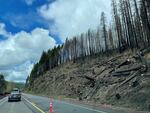
Some hazard trees have been removed from a section of land along Highway 22 near Detroit while others higher on the slope are marked for removal with blue paint.
Cassandra Profita
CDR Maguire owner Duart said he’s proud of the work his company is doing in Oregon to oversee the hazard tree-removal operation.
Duart said his minority-owned company relies on Mason, Bruce & Girard, a Portland-based environmental consulting company, to oversee the hazard tree marking.
“I assure you there are many layers of accountability and quality assurance to ensure that trees will not be cut unnecessarily,” he said.
Reggie Fay with Mason, Bruce & Girard said he worked for months with Tom Ford, the lead arborist for CDR Maguire, to develop protocols for choosing which trees to remove that would withstand public and legal scrutiny.
Ford was later fired from the project after raising concerns that those protocols weren’t properly reviewed before they were implemented.
“There was no roadmap for us. We really started from scratch,” Fay told lawmakers. “An event like this had not happened in Oregon before, and we were very sensitive to public perception of this project. We designed protocols with that in mind. We kept talking and saying to each other: ‘Eventually this may be litigated. People are going to question the work that we’re doing.’”
Fay said that multiple agencies reviewed the protocols before they were implemented, including ODOT and the U.S. Forest Service, while Ford told lawmakers the protocols didn’t get any review that he knew of.
Fay said his company continued to update the protocols into early March, long after Ford was fired from CDR Maguire as lead arborist.
“I can say each addition to the protocols actually made us mark less hazard trees,” Fay said. “We were constantly adjusting the protocols to meet the demands and make sure we were assessing hazard trees appropriately.”
The company is only hiring arborists and foresters with at least five years experience, he said, and because the protocols have changed and the project has evolved, the company started doing “quality control” reviews in early March.
“Whenever you’re in a production environment and you have multiple staff with different backgrounds working on a project, you’re always going to have human error mixed in and people are going to have different judgment calls,” he said.
Mason, Bruce & Girard staff are using Forest Service guidelines for what percentage of bark char, crown scorch and insect presence indicate that a tree is more than 50% likely to die in the next three years, Fay said, and those trees are getting marked for removal. Senior foresters are walking by every marked tree and doing assessments to make sure it was marked properly, he said.
“That gives me confidence that the trees are marked according to the specs,” Fay told lawmakers. “I can’t say we have 100% correctness out there. There probably is some margin of error. But I can say pretty confidently that 95% plus of the trees that have been tagged and are being cut are marked according to the specs that we designed.”
Whistleblowers sound off
Ford told lawmakers that CDR Maguire was pressuring him and Fay to move faster in developing their protocols so that tree marking and cutting could begin.
He said it was “not adequate” for two people to use a “very limited” U.S. Forest Service research paper to develop a protocol for cutting trees that are more than 50% likely to die after three years. He said foresters were marking trees without formal standard operating procedures well into January with unclear communication from CDR Maguire about who was reviewing their work.
“I never saw any vetting of that protocol from any other agency,” he said. “I never had any faith that the decision to start marking trees without any protocol really came from ODOT.”
Chris Vaughan arborist who was hired to work for CDR Maguire in February, said he only worked on the project for a month before leaving because he was uncomfortable with the disorganization, lack of leadership and poor communication he saw.
Vaughan said the project’s guideline of cutting hazard trees within 1.5 tree lengths of a road is “pretty aggressive” and can lead to cutting trees in a swath of 600 feet or more. He said the guidelines for which trees to mark also changed frequently, at one point going from 1.5 tree lengths to 2 tree lengths distance from the road.
He said the paperwork requirements were intense and concerning, the chain of command was “very unclear,” and he never saw anyone from ODOT on the job site.
“I was asked to fraudulently represent safety meetings that never happened in the field,” Vaughan said. “The safety presence was minimal. There was no job hazard training.”
As an arborist on the job, Vaughan said, he would often have to correct major errors like misidentification of a tree as a cottonwood rather than a spruce. He said he saw workers napping on the job and witnessed substance abuse problems that weren’t addressed.
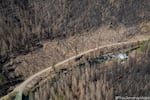
A band of burned trees removed along Highway 224 upslope from a protected Wild and Scenic stretch of the Clackamas River.
Trip Jennings
Eric Phillips was hired to monitor tree removal operations for CDR Maguire, and he said he had a good experience working on a project site on the McKenzie River near Eugene. But then he was assigned to work in other areas, where his experience “started to sour,” he said.
He said he was directed to mark some trees himself using a phone application that was designed to help arborists identify hazard trees. He said he was told to speed up the process by answering “yes” the very first question in the app, “Is this tree dead?”
“I’m not an arborist,” he said. “I have no forestry qualifications at all.”
Other workers on the project have also reported concerns about unqualified people marking trees using a phone application.
“They started to rush the job,” Phillips said. “I started to see a lot of people marking trees using the guidelines in the app, and what surprises me is learning how detailed the guidelines were and yet they were all bypassed.”
Phillips also said he saw huge numbers of trees removed along the Clackamas River and Highway 224.
“Entire areas just clear-cut,” he said. “You’d be astonished at what they’re doing to that valley.”
Phillips said he grew up in Mill City, lived through Oregon’s contentious timber wars and values the forests surrounding his hometown. So, when he saw crews falling large trees into a wetland in the area off Highway 22 that burned in the Beachie Creek fire, he was upset.
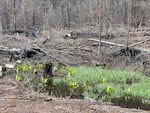
Large trees were felled into a wetland in the area off Highway 22 that burned in the Beachie Creek fire.
courtesy of Ralph Bloemers
“They’re dropping old-growth trees, massive pieces of timber,” Phillips said. “What I saw was them conquering these forests. None of them had cut trees this big. They were totally inexperienced and didn’t care where the timber landed. I saw trees land in the wetlands.”
Phillips said he saw CDR Maguire “pushing boundaries and possibly committing fraud” as he was directed to take on additional responsibilities like tree marking that were beyond his qualifications.
He raised concerns about trees being cut that weren’t marked for removal, he said, and was told the company just wouldn’t get paid for those trees even though there is supposed to be a $2,000 fine for cutting unmarked trees. Phillips said trees that he helped mark were removed a week later without anyone checking their markings.
“It’s terrifying out there in the field,” Phillips told lawmakers. “There’s no oversight in the field out there at all. They did a good job of putting things in writing but nobody’s overseeing it.”
A growing list of problems
Lynne Piper, a property owner in the Elkhorn area of the Santiam Canyon, said she encountered a problem with how the state is marking trees for removal on private property like hers.
Piper said she signed a right of entry form to allow state agencies to clear debris from her burned home, but she specified she didn’t want any additional trees removed. She was surprised to return to her property and see dozens of trees marked for removal going up the slope above her home site.
“We specified we didn’t want the trees cut, and we didn’t receive any notice that the trees were marked,” she said. “We’ve already lost a lot. We’re traumatized. We don’t want to lose anymore.”
Piper said she’s worried that excessive tree-marking on private property is “a money grab at our expense” and pleaded with lawmakers to take action.
“Please, I ask you to stop what appears to be fraud,” she said. “Some people may want their dead trees cut and may want to replant. But we want our soils. … People have a right to keep the land the way they want. Not everybody sees burned trees as a commodity.”
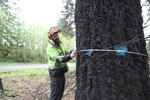
Rick Till, a certified arborist with hazard tree assessment qualifications, examines a large Douglas fir tree that has been marked for removal along Highway 22 near Gates, 2021.
Cassandra Profita / OPB
Rick Till, a certified arborist with hazard tree assessment qualifications, has evaluated some of the trees marked for removal along Highway 22 near Gates and elsewhere in the Santiam Canyon.
He told lawmakers many of the trees he saw that are currently marked for removal are not actually hazardous.
“I saw very little in the way of imminent hazards to the public,” he said, noting several large Doug firs with moderate bark char that still have green needles on the majority of their canopy.
“I’m a trained, qualified tree assessor and I cannot imagine how you could mark a tree like that as a hazard to the public,” he said. “It’s inconceivable to me, and I saw that on a scale throughout the valley: A lot of green trees marked for removal based on, in many cases, cosmetic burn damage.”
After hearing the allegations against ODOT’s project contractors, Lynde indicated his agency is taking them seriously.
“There’s some alarming accusations we heard in presentations today, ones that we don’t take lightly,” he said.
He said ODOT is notifying homeowners of hazard tree marking on their properties.
“Unfortunately, it sounds like that didn’t occur,” he said in response to Piper’s testimony.
But he reiterated the importance of removing dangerous trees along state roads.
“The urgency of removing trees along the highway is paramount,” he said. “We don’t want to cut more trees down than we have to.”
Lawmakers ran out of time as they were starting to ask pointed questions of ODOT, CDR Maguire and Mason, Bruce & Girard leaders, so they agreed to continue the hearing at a later date, and noted that the House Wildfire Recovery Committee will be holding a hearing of its own on Friday at 10 am.

